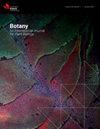木本植物梭梭(C.A.Mey.)为研究风蚀胁迫下的自疏关系和大小不平等提供了新的见解
IF 1.3
4区 生物学
Q3 PLANT SCIENCES
引用次数: 0
摘要
植物的自疏过程和大小不等随树龄和风蚀胁迫条件的变化而变化。本研究以梭梭灌木幼树期(1 ~ 6年)为研究对象。研究了它们的密度、高度和存活率。利用泰勒幂定律计算了密度均值与密度变化的关系,分析了密度聚类状态的变化规律。此外,还研究了尺寸不均匀的变化和自薄过程。结果表明:在相同风蚀应力下,自疏坡为正(P < 0.05);梭梭灌丛密度聚集随着风蚀胁迫的增加而增大。随着发育阶段的推进,大小不平等先增大后减小。在相同的应激条件下,竞争指数随年龄的增加而增加,随应激的增加而降低。研究表明,在较恶劣的植物生长微环境下,植物聚集和生长的便利性增加,导致个体之间积极和消极相互作用的净效应发生变化。此外,结果显示,随着年龄的增长,大小不平等是左偏的。本文章由计算机程序翻译,如有差异,请以英文原文为准。
The woody plant Haloxylon ammodendron (C. A. Mey.) provides new insights into the self-thinning relationship and size inequality with wind erosion stress
The self-thinning process and size inequality of plants change with age and wind erosion stress conditions. In this study, we used Haloxylon ammodendron shrubs in their juvenile stage (1–6 years) were the study subjects. Their density, height, and survival were investigated. The relationship between the mean and variation in the densities was calculated using Taylor’s power law, and the change laws of the density clustering state were analyzed. Additionally, changes in size inequality and the self-thinning process were examined. The results indicated that under the same wind erosion stress, the self-thinning slope was positive (P < 0.05); the shrub density aggregation of H. ammodendron became denser with increasing wind erosion stress. The size inequality first increased and then decreased as the developing stage progressed. Under the same stress, the competition index increased with increasing age and decreased with increasing stress. We demonstrated that under a harsher microenvironment for plant growth, plants clustering and growth increased facilitation, resulting in a shift in the net effect of the positive and negative interactions between individuals. Furthermore, the results revealed that as age increased, the size inequality was left-skewed.
求助全文
通过发布文献求助,成功后即可免费获取论文全文。
去求助
来源期刊

Botany
生物-植物科学
CiteScore
2.20
自引率
9.10%
发文量
48
期刊介绍:
Botany features comprehensive research articles and notes in all segments of plant sciences, including cell and molecular biology, ecology, mycology and plant-microbe interactions, phycology, physiology and biochemistry, structure and development, genetics, systematics, and phytogeography. It also publishes methods, commentary, and review articles on topics of current interest, contributed by internationally recognized scientists.
 求助内容:
求助内容: 应助结果提醒方式:
应助结果提醒方式:


